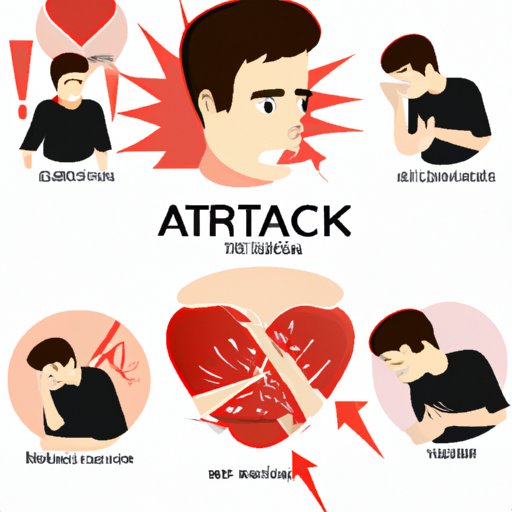
Introduction
Heart attack is a silent killer that affects millions of people around the world every year. This dangerous condition happens when blood flow to the heart is blocked, causing irreversible damage to this vital organ. Recognizing heart attack symptoms is crucial, as this can lead to timely treatment and, ultimately, save lives. In this article, we will explore what causes heart attacks, their symptoms and how you can take steps to protect your heart health.
The Silent Killer: Understanding Heart Attack Symptoms and What to Do About Them
A heart attack occurs when blood flow to the heart muscle is blocked, which can cause damage or death to the heart tissue. The most common cause of heart attack is a buildup of plaque in the arteries that supply the heart. This can be caused by several factors, including obesity, lack of exercise, and smoking, among others.
Preventing a heart attack is the first step in protecting your heart health. Maintaining a healthy lifestyle that includes a balanced diet, regular exercise, and avoiding tobacco smoke are essential. Also, reducing your risk factors, such as high blood pressure, high cholesterol, and diabetes, is important. By managing these health conditions, you can help prevent a heart attack.
Listen to Your Body: Recognizing the Warning Signs of a Heart Attack
Heart attack symptoms can differ between men and women, and some symptoms can be subtle and easily ignored. Common warning signs of heart attacks can include chest pressure or discomfort, shortness of breath, nausea or vomiting, and pain or discomfort in the arms, neck, jaw or back.
Subtle signs of heart attack that are often ignored include fatigue, lightheadedness, or fainting. It is crucial to differentiate between a heart attack and other cardiovascular problems, such as angina, which can be mistaken for a heart attack. Angina is usually experienced as a recurring pain or discomfort in the chest, arms, neck, jaw or back.
Don’t Ignore the Signs: A Comprehensive Guide to Heart Attack Symptoms
Heart attack symptoms can vary depending on the type of heart attack. There are three types of heart attacks: ST-segment elevation myocardial infarction (STEMI), non-ST-segment elevation myocardial infarction (NSTEMI), and silent myocardial infarction (SMI).
STEMI is the most severe form of a heart attack and requires immediate medical attention. Symptoms of this type of heart attack can include severe chest pain, shortness of breath, and discomfort in the arms, neck, jaw, or back.
NSTEMI is a less severe form of heart attack, and symptoms can include chest pain that is milder compared to STEMI, shortness of breath, and discomfort in the arms, neck, jaw, or back. It is essential to seek medical attention if symptoms persist.
SMI, also known as a silent heart attack, does not produce any noticeable symptoms, leading many people to remain unaware that they have suffered a heart attack. It is essential to undergo routine medical check-ups to identify any underlying heart diseases.
Identifying Heart Attack Symptoms: A Lifesaving Skill Everyone Should Know
Recognizing heart attack symptoms is a lifesaving skill that everyone should know. If you experience any of the symptoms mentioned above, seek medical attention as soon as possible. Time is of the essence, and receiving prompt treatment can help prevent further damage to your heart.
The steps to take when experiencing heart attack symptoms include calling 911 and seeking prompt medical attention. Anyone who experiences a heart attack should avoid driving and take medication as prescribed by a healthcare provider.
It is also important to know when to call 911. If you are experiencing chest pain or other heart attack symptoms, call 911 immediately, as this can help you receive lifesaving treatment in a timely manner.
The ABCs of Heart Attack Symptoms: Knowing the Basics Could Save Your Life
The “ABCs” (airway, breathing, circulation) are essential in identifying heart attack symptoms. This technique can help determine if a person is experiencing a heart attack or a related medical emergency.
The “ABCs” can help identify heart attack symptoms by ensuring that the person’s airway is open, their breathing is stable, and their circulation is sufficient. If you recognize any heart attack symptoms, such as chest pain or discomfort, call 911 immediately.
It is essential to take action quickly in case of a heart attack. The longer a heart attack is left untreated, the more damage can be done to the heart, leading to potentially serious complications.
Heart Attack Symptoms: What You Need to Know to Protect Your Heart Health
Lifestyle changes are an essential step in preventing heart attacks. This includes avoiding smoking, maintaining a healthy weight, engaging in regular exercise, and eating a balanced diet. It is also important to manage any existing medical conditions effectively.
Managing pre-existing conditions, such as diabetes, high blood pressure, or high cholesterol, can help reduce the risk of heart disease and heart attacks. It is essential to undergo routine medical check-ups to monitor your overall heart health and ensure that any underlying health conditions are treated promptly.
Conclusion
Heart attacks are a common occurrence, but knowing the warning signs and taking prompt action can prevent further damage to your heart. If you believe you are experiencing heart attack symptoms, call 911 immediately, and seek prompt medical attention. By maintaining a healthy lifestyle and managing any existing medical conditions, you can protect your heart health and prevent heart attacks from impacting your life.





